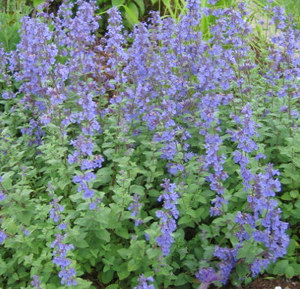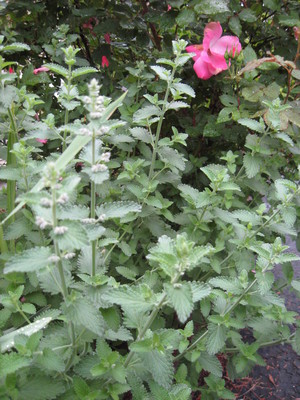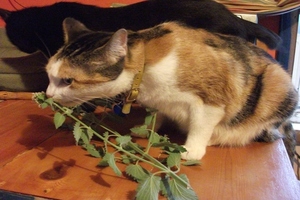Traditionally seen in an English Garden, catmint has gotten its popularity from the furry friends, the cat. Catnip is a wild plant that grows naturally in zones four to eleven. As many people know, catnip is also known as a natural drug for cats, since the smell allures all neighborhood cats to the growing plant. There is an old English saying that states “If you set it, the cats will eat it; if you sow it the cats don’t know it.” This old English saying comes from the fact that a cat will not know if catmint is being grown, until the leaves are broken. Once the leaves are broken for any reason, such as transplanting it, all neighborhood cats will come and feast on it until the plant is no longer.
Throughout the history of this plant, it has been known for medicinal cures, English e teas and as an edible plant. The flowering tops are known to have been used for curing colds since in produces perspiration without increasing the body heat of the person. In addition, it is good for restlessness, insomnia and some believe its help cure insanity. None of these have been scientifically tested though in a research situation. Some natural herbal doctor still use the catnip mixed with boiling water twice a day for such things as colicking, hysteria, constipation and to relieve common pain. During ancient times, the English preferred to drink catmint tea before the exportation of Chinese green teas.
Catmint prefers to be planted in well-drained soil and will grow around 18 inches to around 3 feet in height. Once planted though, it is wise not to transplant it – otherwise your garden will become very popular among the cats. It prefers to have a normal amount of watering, however can be damaged with too much water unlike other mint varieties. Catmint is perfect for those gardeners that do not like to water a lot since it prefers drier locations. It is better to let this plant just grow naturally; if done this way, one plant will germinate naturally for around five years. If planting more than one plant at a time, it is best to plant it about 20 inches from each other to provide space for growth in the future. This flower showcases numerous bluish/lavender blooms during June and July. For this reason, it is perfect to plant around the edge of a garden as a border or interfused throughout the garden for added color. If the color fades a little, try placing a little fireplace ash around the roots which will deliver the full color back to life.
Catmint is an altogether perfect border plant that adds wonderful blooms throughout the dry summer months. In addition, it is perfect for those gardeners that hate to water and tend to forget to turn on the sprinkler system on those hot days. For those gardeners that have cats, it can be broken up and given safely to a cat or dried for the winter months. In addition, as a substitute to chamomile tea, try steeping it into some green tea and benefit from the “healing powers” it has been historically noted to give off. Otherwise, this plant is perfect just for the added beauty in ones garden.





